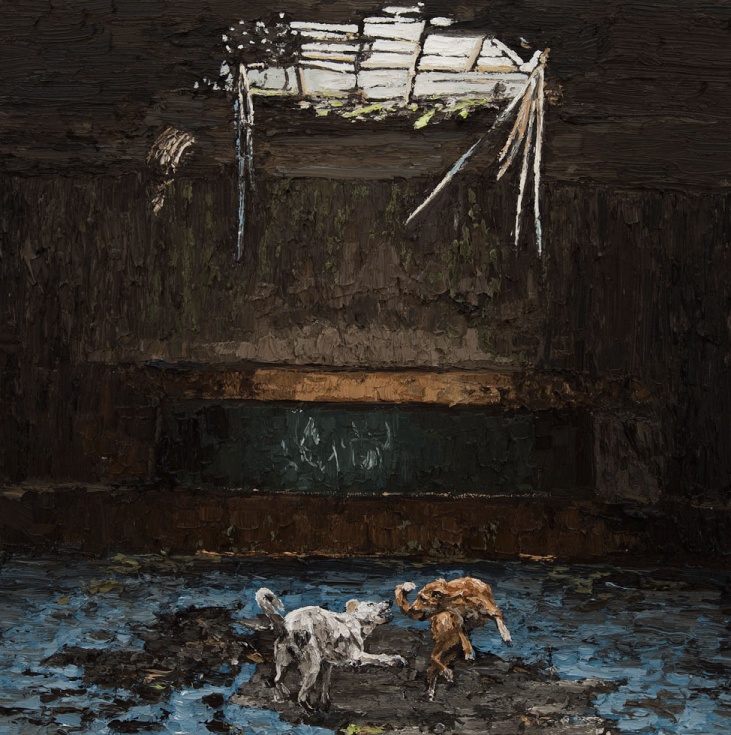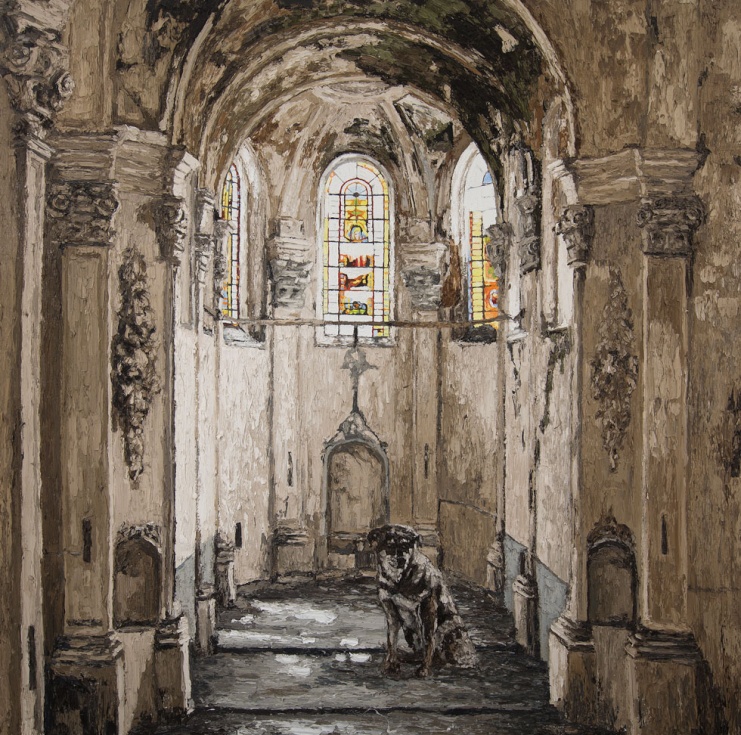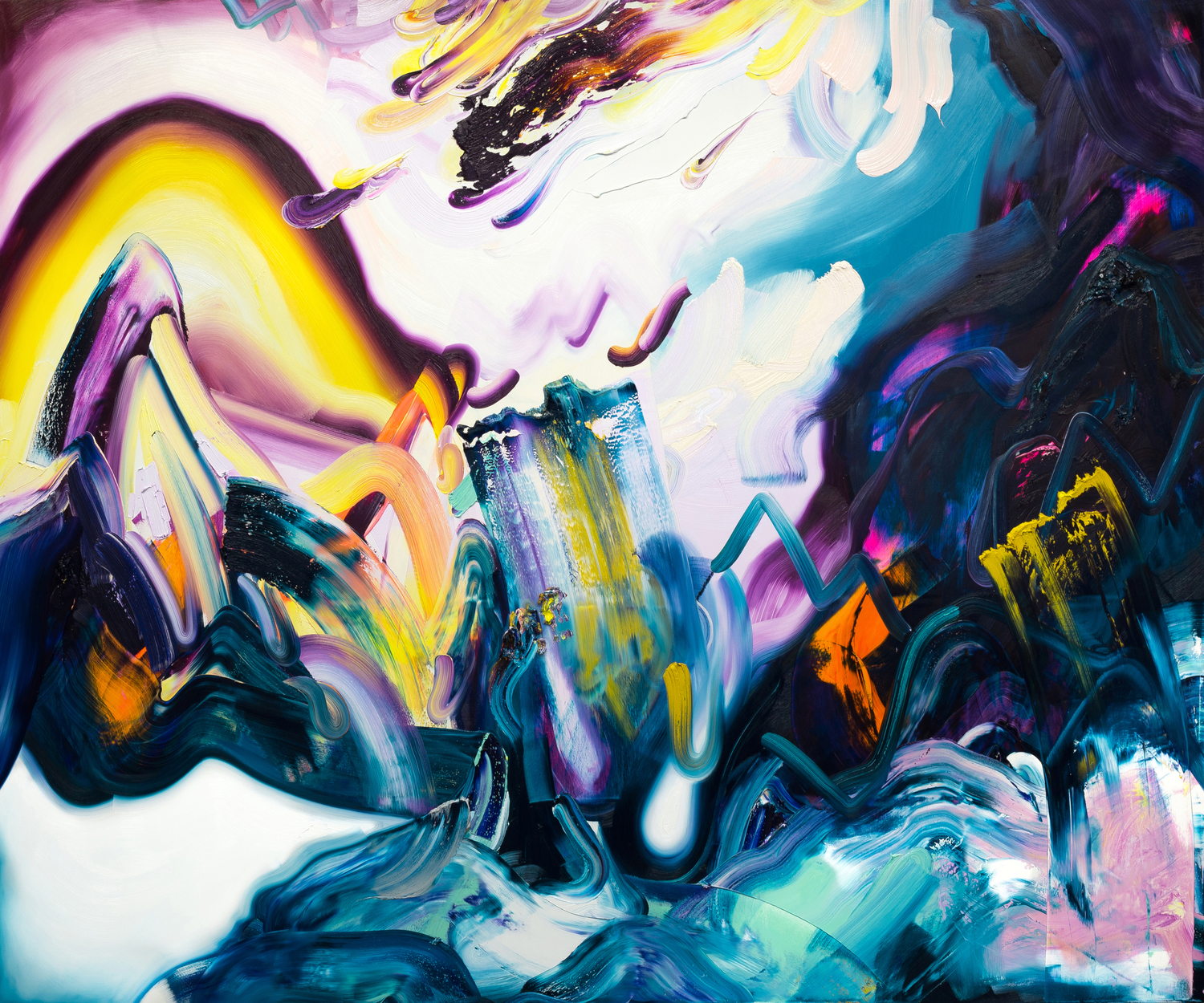Catalogue Essay by Randy Gladman for LE Gallery
A vast promise of better times ahead sweeps through the paintings of Matt Bahen. Earthy and grounded, his allegorical landscape scenes whisper of turning points in history. These are the moments when all is finally quiet on the northern front as periods of unseen chaos finally fade into the past. In these moody, contemplative and lonely works, battlefields hesitantly begin to give way to forces of growth; animals return to destruction-scarred locations, now neglected by their departed human lords, bringing with them natural balance, hazy potential, and new peace. The footprints of evil, so recently impressed into the frozen muck of cold, empty and miserable winters, loosen and melt away. What is left is a ruined yet clean slate, the chance for new shoots to root, deliverance. Metaphors for the redemptive force of nature, these sensitive paintings reflect the difficult road this artist has traveled and his intimate experience with the power of healing.
Raised in Schomberg, Ontario, a small suburb of a large suburb, Bahen headed south to Toronto after high school to work towards a Bachelor of Fine Arts at the Ontario College of Art and Design (OCAD). Without significant family resources to provide financial sustenance, side work as a construction labourer was necessary to cover the multitude of expenses he faced as a student. An illness towards the end of his first year and lasting through the summer months resulted in a serious cash shortfall as his second year of school arrived. Though he managed to come up with enough to pay for tuition and art supplies, Bahen had nothing left for rent, but chose to forge ahead and spent much of the next year living out of a dufflebag, sleeping wherever he could; surfing on understanding friends’ couches, hiding overnight inside the halls of OCAD with the unspoken complicity of understanding professors, or on the rare occasion wandering around the city waiting for morning. Dealing with the daily grinding effort of trying to secure accommodation for the coming night, Bahen somehow managed to stay focused on his studies and continued to earn praise from his teachers.
Within a year, Bahen overcame his illness but another setback struck shortly after his graduation when a gruesome workplace incident on a construction site resulted in the bloody dismembering of three of the fingers on his left hand. His fingers were successfully reattached through a series of painful surgeries but this event was another serious blow to his progress and added to a growing pile of experiences of deprivation and hardship.
Realizing all too clearly that the building industry had not been kind to him, he began a professional transition from construction to social work. For the past 7 years, he has worked for the Sherbourne Health Centre driving their street outreach bus. His work involves bringing socks, clean needles, condoms, and human dignity to the invisible urban multitudes that suffer on the meaner streets ofToronto, trying connect them back into mainstream services and communities.. The efforts required by this work take a serious toll on his soul and energy but he derives strength from the knowledge that he is delivering necessities of life to the weakest and most needy. This employment evolution materialized visibly in the content of his paintings. Concurrent with the start of his street outreach work, Bahen’s painted narratives turned away from images of the machines of war common in his student work towards an emotional interest in the victims of conflict. The pain and misfortune he experienced and witnessed now lay the foundations of a generous and hopeful painting practice; his impressively prolific catalogue of paintings, all of which reveal a deep connection to suffering, loss, promise and rebirth, now explore the brutal results of conflict rather than a fascination with the instruments that produce it. Scenes of sad lines of refugees, mega tent cities, and inadequate Red Cross efforts replaced images of helicopter gunships and fighter pilot helmets. These gradually transitioned again; his recent works take viewers to a more hopeful place where conflicts have ended and new chapters are just beginning.
A straight line through art history reveals the many artistic influences seen in Bahen’s paintings. The 19th century German Romantic landscape painter Caspar David Friedrich (1774-1840) is as good a place to start as any in an analysis of Bahen’s work. His images of gothic ruins and tragic landscapes inspire Bahen’s similar contemplation of nature, spiritual architecture, and growing disillusionment with a materialistic society. Friedrich’s subjective and emotional response to the relics of passing human activity, as seen in works such as “Abbey in the Oakwood” (1808-1810), are picked up by Bahen in much of his recent work, as are his explorations of barren winter vistas.
Friedrich’s harsh and fearful interpretation of nature is similarly evident in the works of the great Canadian painter Tom Thomson (1877-1917), the figurehead — if not a member – of the Group of Seven, whose own story and output exerted great attraction for Bahen in his youth. Thomson’s ability to delineate the severe hardness of the northern landscape through paint remains a goal Bahen reaches out to grasp. An icy wind appears to blow through most of Thomson’s work; stand close to Bahen’s canvases and you can feel the same bitter breeze.
Anselm Kiefer (born 1945) was born in Donaueschinger, Germany, during a heavy allied bombing campaign during World War II and this artist’s work has also had a pronounced influence on Bahen’s artistic output. Kiefer’s dense, coagulated paintings of somber, deadly and earnest imagery leave an indelible imprint on Bahen’s own efforts, the results of which can be viewed in both artists’ barren landscapes, apocalyptic visions, dark tones, and primordial use of texture. Through the 1970s, Kiefer focused on lands where historic events might have occurred and offered pictures of broken fields with an imposing high horizon line and earthy tones. Employing similar aesthetic devices, Bahen’s images of the Ontario landscape loosely resemble Kiefer’s representations of his equally Nordic German natural environment and bear similar tragic marks left on the land by military devastation. Whereas Kiefer’s notions of loss are inspired by personal experiences with warfare and Bahen’s are derived from more intimate traumas and negative economic realities, the deprivations experienced are parallel and both artists attempt to deal with the disruptive aspects of hardship through metaphorical images of the landscape and its natural occupants.
There is an optimism present in Bahen’s work (and personality), however, and this influence can perhaps be tied to the time he has spent with John Scott (born 1950), the important Canadian artist who was the first-ever recipient of the Governor General’s Award for Visual Art in Canada (2002). Though Scott’s themes deal with the omnipotent threat of 21st century militaristic destruction, there is also a sublime playfulness and looseness in his work which has directly impacted the manner in which Bahen crafts his images. Bahen first encountered Scott as his student at OCAD; they came to be close friends during the ensuing years that Bahen worked in Scott’s studio as an assistant. Bahen today considers himself a protégé or disciple of Scott and attributes his time with his mentor for his ability to engage with political ideas in a smart way yet simultaneously to let go, be intuitive, work in a less regimented manner, and ensure that art making remains positive and attractive. Though both men have suffered from cold, hard reality checks (Scott has been struck by lightning on two occasions resulting in serious health issues), they maintain their idealistic outlooks and incorporate some of their hardest experiences into their art with honesty, dignity and imagination.
The destroyed buildings and ignored fields Bahen paints may speak of terror, but his canvases tell tales of evil that has already happened. Past tense. The foreboding sense present in his works is dissipating, fading away. The tragedies have now slipped into history and new chapters of hope have begun. The machines of war that now appear in his paintings are already destroyed, their ability to wreak havoc impotent and decaying. His cornfields are fallow and unproductive but they are not permanently ruined and, with some care and hard work, they will once again provide the necessities of life. Though humans are not present, their animals have come back and appear to be healthy, returned to a state of wild un-domestication, once again the masters of their domains. Even the vast, bleak expanses of snow and ice appear to be melting, with freshwater streams cutting through breaks in the naked stands of leafless trees. Winter, Bahen suggests, inevitably makes way for spring and night is always darkest just before the dawn.
Originally published by Le Gallery for the exhibition catalogue for “After Wolves” by Matt Bahen, March 2012.



